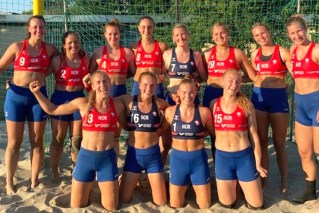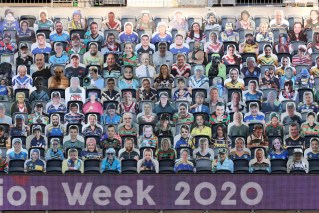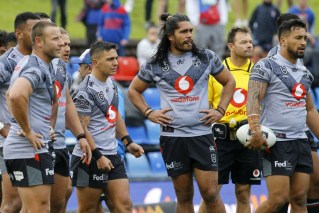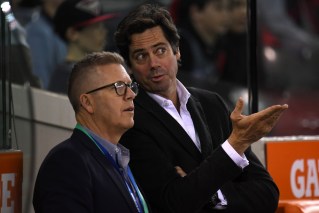Warnie and the boys are a boon for women’s sport

For those who have spent decades in the trenches fighting for decent recognition – never mind parity – for women’s sport, the task has been relentless and largely unrewarding. Many have fallen by the wayside.
But, at the risk of getting over-excited about what at this stage is no more than a blip, the emergence of the Southern Stars, Australia’s all-conquering women’s cricket team, provides some small cause for optimism.
They won’t be naming grandstands after Meg Lanning and co. any time soon, but the Southern Stars model provides an interesting study in how women’s team sport might – just might – start to make an impact on the broader sporting community.
The first point is that the women, and their female coach Cathryn Fitzpatrick, deserved their victory and every skerrick (and more) of the meagre coverage they gleaned.
Big congrats to @meglanning7 and the @southernstars on a third straight World T20 win! Awesome effort
— Michael Clarke (@MClarke23) April 7, 2014
To watch Lanning was to watch a sublime sportswoman at work, a batter who from her first delivery combined style, deft touch and raw power to help put England to the sword.
Renaissance woman Ellyse Perry – sometime Matilda, sometime Southern Star – again batted and bowled with distinction. Perry is at once a nostalgic throwback to the days of amateur all-rounders, and a reminder of how far women’s sport lags behind the men in terms of professionalism. (Think David Warner lining up for the Socceroos in Brazil.)
Then there was the catching at the wicket of Alyssa Healy (Yes, she is Ian’s niece), the nagging medium pacers of Sarah Coyte, the outfield catching and so on …
But there was something else happening as the Australian women marched to victory: the respect with which the mainstream cricket community – that is, the men’s cricket community – treated the Australian players and their performance.
Sing it loud ladies @Southerstars pic.twitter.com/XZaIeeEy88
— Adam Gilchrist (@gilly381) April 6, 2014
Because the tournament was held concurrently with the men’s World T20, countless luminaries were on hand to describe and comment on the women: Shane Warne, Nasser Hussain and Ian Bishop in the commentary box; Allan Border and Mark Waugh back in the Fox studios in Australia.
They were respectful, rarely patronising and there was no hint of the Channel Nine boys club. OK, so Warnie referred to the Australians as “ladies”, and Mark Waugh might have compared Lanning with the blokes, but these guys are not exactly gender studies graduates.
More important was what Waugh said about Lanning: “That’s as good as you see the men bat – the power and the poise and the technique. She’s got a presence about her at the crease. If she’s not the best player going around, I’m a bad judge.”
Former players of the stature of Mark Waugh and Shane Warne speaking in those terms about women cricketers counts for more than any number of unread government reports on equitable media coverage or disregarded letters to the editor.
Congrats to all the @SouthernStars on winning #wt20final, awesome effort I’m taking over the @ICC twitter account 815pm local time #askshane
— Shane Warne (@warne888) April 6, 2014
The truth is that the demise of traditional media and the emergence of the digital model mean that any chance of affirmative action is finished. If it does not attract clicks, it won’t run. And the unjust but harsh reality is that women’s sport does not rate.
You can forget the hockey, gymnastics, or water polo teams ever emerging from the sporting fringe. Even the swimmers are largely ignored outside of Olympic Games. The jury is out on whether the Matildas will be embraced as they should be, and the A-League’s women’s clubs struggle for attention. The netballers have made great strides, but are still outside the mainstream.
Most outrageous has been the lack of appreciation of our women athletes, who have dramatically outperformed the men for more than 40 years. (The women have won eight major titles on the track in that period; the men only one, to Robert de Castella). Sally Pearson should be a household name, while Jana Pittman was dismissed as some sort of highly strung novelty, despite being an athlete of substance who won two world titles.
It might seem defeatist, but that is why it is so important that, after years of neglect, the mainstream cricket fraternity has embraced the women’s game.
Amazing effort @southernstars and skipper @meglanning7! T20 world champs again, 3 in a row!
— Aaron Finch (@AaronFinch5) April 7, 2014
Yes, the women deserve their own stage. But there is not much point if nobody is watching.
If playing tournaments concurrently with the men increases the focus on the women, that can only be a good thing. If staging women’s curtain raisers before men’s Twenty20 matches increases crowds exponentially – which it does – then it is a policy worth pursuing. If having Warnie in the commentary box sparks interest, go for it.
The twitter accounts of the Australian male players go well beyond politically correct lip service. They began well before the tournament started, so cannot be dismissed as the (losing) men hopping aboard the (winning) women’s bandwagon.
They suggest there is a new attitude brewing. With it comes a bud of optimism.








